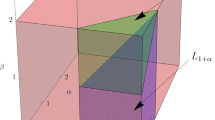Abstract
We show a Cameron–Martin theorem for Slepian processes \(W_t:=\frac{1}{\sqrt{p}}(B_t-B_{t-p}), t\in [p,1]\), where \(p\ge \frac{1}{2}\) and \(B_s\) is Brownian motion. More exactly, we determine the class of functions \(F\) for which a density of \(F(t)+W_t\) with respect to \(W_t\) exists. Moreover, we prove an explicit formula for this density. p-Slepian processes are closely related to Slepian processes. p-Slepian processes play a prominent role among others in scan statistics and in testing for parameter constancy when data are taken from a moving window.
Similar content being viewed by others
References
Abrahams, J.: Ramp crossings for Slepian’s process. IEEE Trans. Inf. Theory 30(3), 574–575 (1984)
Adler RJ (1990) An introduction to continuity, extrema, and related topics for general Gaussian processes, Hayward, Calif., Institute of Mathematical Statistics, Lecture notes, monograph series 12
Bar-David, I.: Radon–Nikodym derivatives, passages and maxima for a Gaussian process with particular covariance and mean. J. Appl. Probab. 12, 724–733 (1975)
Bischoff, W., Miller, F.: Asymptotically optimal tests and optimal designs for testing the mean in regression models with applications to change-point problems. Ann. Inst. Stat. Math. 52, 658–679 (2000)
Bischoff, W., Hashorva, E.: A lower bound for boundary crossing probabilities of Brownian bridge with trend. Stat. Probab. Lett. 74, 265–271 (2005)
Cameron, R.H., Martin, W.T.: Transformations of Wiener integrals under translations. Ann. Math. 45, 386–396 (1944)
Chu, C., Hornik, K., Kaun, C.: MOSUM tests for parameter constancy. Biometrika 82, 603–617 (1995)
Cressie, N.: The asymptotic distribution of the scan statistic under uniformity. Ann. Probab. 8, 828–840 (1980)
Gao, F., Li, W.: Small ball probabilities for the Slepian Gaussian fields. Trans. Am. Math. Soc. 359(3), 1339–1350 (2007)
Gegg, A. (2013) Moving Windows zum Auffnden von Change-Points. Doktor Thesis (in German), Catholic University of Eichstätt-Ingolstadt
Jamison, B.: Reciprocal processes: the stationary Gaussian case. Ann. Math. Stat. 41, 1624–1630 (1970)
Lifshits, M.: Lectures on Gaussian processes. In: SpringerBriefs in Mathematics. Springer, Berlin (2012)
Liu, J.V., Zongfu, H., Mao, H.: Karhunen–Loève expansion for additive Slepian processes. Stat. Probab. Lett. 90, 93–99 (2014)
Mörters, P., Peres, Y.: Brownian motion. Cambridge Series in Statistical and Probabilistic Mathematics 30. Cambridge University Press, Cambridge (2010)
Nikitin, Y.Y., Orsingher, E.: Sharp small ball asymptotics for Slepian and Watson processes in Hilbert norm. (Russian) Zap. Nauchn. Semin. POMI, 320, 120–128 (2004), translation in J. Math. Sci., New York, 137(1), 4555–4560 (2006)
Shepp, L.A.: Radon–Nikodym derivatives of Gaussian measures. Ann. Math. Stat. 37, 321–354 (1966)
Shepp, L.A.: First passage time for a particular Gaussian process. Ann. Math. Stat. 42, 946–951 (1971)
Slepian, D.: First passage time for a particular Gaussian process. Ann. Math. Stat. 32, 610–612 (1961)
Author information
Authors and Affiliations
Corresponding author
Appendix
Appendix
Proof of Lemma 3.1
Let \(\frac{1}{\sqrt{p}}\nabla _p s_{f}\in \mathcal {H}_{p-\text {Sl}}, f\in L^2[0,1]\), be arbitrary and let \(1/2\le p\le 1\). There are several places where the case \(p=1/2\) must be considered separately. We do not do this since the specifications for \(p=1/2\) are simpler than the following considerations for \(1/2<p\le 1\). By proposition 4.1 of [12], we get
where the second equality follows by Theorem 1.3. Each function \(f\in L^2[0,1]\) can be written \(\lambda -a.s.\) in the form
where
Note that the six summands in (7) build orthogonal functions in \(L^2[0,1]\). In the following, we use the consequence of this representation at several places without citing it explicitly. Furthermore, we have
Next, we consider \(g\in L^2[0,1]\) of the specific form
Hence,
and
Thus, \(\nabla _p(g)(t)=s_g(p)+\delta t, t\in [p,1]\). Let \(g_0(t)=\alpha _0 \mathbf{1}_{[0,1-p]}(t)+\beta _0\mathbf{1}_{(1-p,p)}(t)+(\alpha _0+\delta _0)\mathbf{1}_{[p,1]}(t)\in L^2[0,1]\) be fixed and let \(g\in L^2[0,1]\) with \(\nabla _p(g)(t)=\nabla _p(g_0)(t)=s_{g_0}(p)+\delta _0 t, t\in [p,1]\). Then,
and the square of its norm is given by
This norm is minimal if and only if
Hence, we obtain after some calculation
Next, we consider a general function
By the above considerations, we obtain
where the minimum is taken over all \(a:[0,1-p]\rightarrow \mathbb {R}, b:(1-p,p)\rightarrow \mathbb {R}, c:[p,1]\rightarrow \mathbb {R}\) with \(s_a(1-p)=s_b(2p-1)=s_c(1)=0\) and \(c(t)-a(t-p)=f(t)-f(t-p)-\delta \). It holds true for \(t\in [p,1]\) fixed
where the minimum is taken over all \(a(t-p), c(t)\in \mathbb {R}\) with \(c(t)-a(t-p)=f(t)-f(t-p)-\delta \). Hence,
This minimum is obtained at the function
Proof of Lemma 3.2
We have to prove Eq. (1) for the p-Slepian-process. To this end, let \(p\le t\le 1, f\in L^2[0,1]\) and \((\nabla _p s_f)(\cdot )=s_f(p)+s_{\nabla _p f}(\cdot )\in \mathcal {H}_{p-\text {Sl}}.\) It holds true for \(t\in [p,1]\):
Rights and permissions
About this article
Cite this article
Bischoff, W., Gegg, A. The Cameron–Martin Theorem for (p-)Slepian Processes. J Theor Probab 29, 707–715 (2016). https://doi.org/10.1007/s10959-014-0591-7
Received:
Published:
Issue Date:
DOI: https://doi.org/10.1007/s10959-014-0591-7



